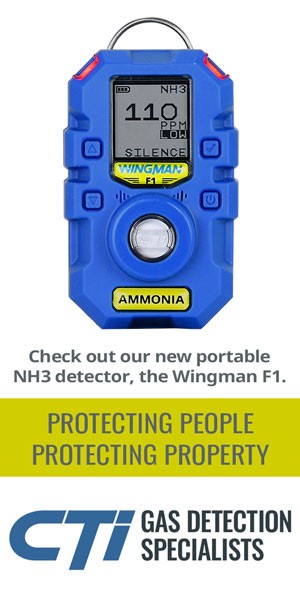How much is in the system?
BY KEM RUSSELL

One reason is compliance with federal safety and risk-management regulations. If the system is over the threshold quantity of 10,000 pounds, then it is subject to both the OSHA Process Safety Management (PSM) program and the EPA Risk Management Program (RMP). Additionally, some states may have more stringent program levels.
The second reason is, if the quantity is 500 lbs. or more, then it must be reported annually as part of Tier II. Tier II reporting is not difficult to do, but if not properly done state and local agencies and responders will not know that you have ammonia or other hazardous chemicals on-site. As with the PSM and the RMP programs, there are potentially serious penalties for not complying with these requirements. The majority of ammonia systems have over 500 lbs., but with the introduction of low-charge systems, some have less than 500 lbs. Even systems operating under that threshold must comply with federal General Duty Clause requirements. The important thing is to know how much is in the system.
There are at least three ways to determine how much is in a system.
If the system is new and this is the initial charging of the system, sizing it should be relatively simple. An accurate amount of ammonia can be obtained from the ammonia supplier or installing contractor. At least you know how much was put in on day one, which may not be the case after the system has been in use.
If the system has been in operation for some time, calculating the amount of ammonia can be done either by pumping down the system, or by calculating the volume of all the vessels, pipes and valves in the system.
Pumping down can be fairly accurate, but difficult. A good system pump-down could take several attempts, and likely several days. It is somewhat of a challenge pumping out the ammonia from insulated vessels and piping due to the decreased heat input that would vaporize the liquid ammonia.
How well the pump-down goes also depends on how low the system can be pulled down. A system should be pulled into a vacuum, then left to sit for some time. Likely the pressure will increase, indicating there is still ammonia in the system that needs to be pumped back. Ideally, a system is pumped down enough so that the pressure in the system does not rise, but instead remains in a vacuum.
Many systems cannot do a total pump-down because the system cannot be shut down long enough for this to happen, and/or there is not sufficient storage volume in the high-pressure receiver or other potential storage pressure vessels to hold the entire charge. With many large systems, this is the case, so volume must be calculated.
IIAR has provided tables and charts in the “Process Safety Information” section of the PSM/RMP guidelines. The tables and charts can be very helpful in coming up with a calculated estimate of the total ammonia charge. However, it will require some investigative work.
The method of calculating the total ammonia charge is challenging. You need to know the size and length of every ammonia pipe in the system, the operating temperature of the ammonia in those pipes and what phase the ammonia is in. The pipe may have liquid, vapor, or two-phase flow. The more accurate the information on all these factors, the better the result. Fortunately, most refrigeration equipment manufacturers provide the estimated ammonia charge for their equipment.
The tricky part of calculating the total charge is that the estimate must be based on a “snapshot in time” that best fits the systems “typical” operation. It’s tricky because a “typical system operation estimation” could miss by a lot on several occasions.
For example, for several years the charge in a system I encountered had been calculated and re-calculated. It was clear from all of these calculations that the system had over 10,000 lbs. of ammonia. As the calculation was refined, the total charge amount increased to nearly 20,000 lbs. The charge amount was reported on the facility’s Tier II, on the submitted RMP, and documented in their PSI section of the PSM/RM Program.
I happened to be at their plant auditing their PSM/RMP, and mentioned to the chief engineer, “It sure would be nice if you could totally pump down the system”.
Fortunately, the facility was going to shut down completely for some weeks, so the chief said he would do a good pump down with the shut down. The system had two good-size high-pressure receivers, so it seemed possible that the system could be totally pumped down.
I checked in with the chief a couple of weeks later and he told me he had done multiple pump downs of the system. He was going to do a couple of more just to be sure, but he figured he wouldn’t be getting much if anything back.
The system’s two high-pressure receivers were interconnected with isolation valves. The chief engineer said that one of the receivers had been totally emptied and isolated some time ago, so the total system charge fit into the other receiver.
He explained the depth of the vessel, the vessel size (OD and length), and the pressure in the vessel. Using that information, I calculated the amount of ammonia.
“That can’t be right,” I said to myself. I calculated it again. Same answer. The amount was significantly less than 10,000 lbs. How could that be?
The lesson learned: you must base the charge calculation on a point in time when you can accurately estimate how much ammonia is in all the piping, vessels and equipment. In this case, the previous calculations had assumed, incorrectly, that everything in the system would be operating simultaneously. The chief said all the equipment is not operated at the same time, only those pieces required for the production being done.
This particular facility has a complete PSM/RMP, which they will continue. However, now the discussion is: might something change in the future requiring more ammonia, or should the facility be deregistered with EPA? The Tier II report will also have to be updated.
If the only reasonable approach is to calculate the amount of ammonia in a system, take the time to find out what really is operating and the conditions of operation. Don’t assume you know that answer already.













